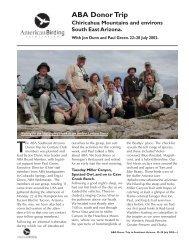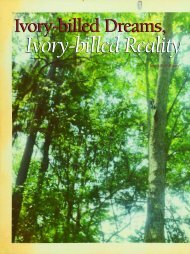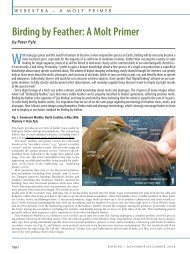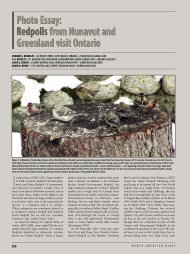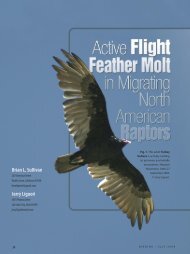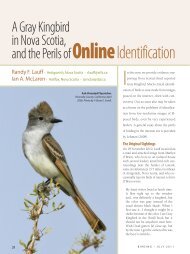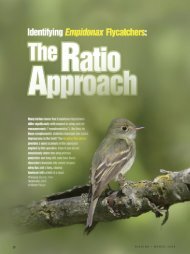Front End - American Birding Association
Front End - American Birding Association
Front End - American Birding Association
You also want an ePaper? Increase the reach of your titles
YUMPU automatically turns print PDFs into web optimized ePapers that Google loves.
Grasshopper Sparrow, Chestnut-collared Longspur; one by one they were added. Unfortunately,<br />
the staked-out Burrowing Owl was nowhere to be found, nor could we find Willow<br />
Flycatcher or Baird’s Sparrow. The latter species has taken a real nosedive in the<br />
province recently. With light fading and at 214 species, we had run out of possibilities.<br />
However, the record was ours again and the celebratory beer at the Melita Motor Hotel<br />
sure tasted good afterwards!<br />
ONTARIO #1 – 5 Sep 08- 0512 to 2030 – Species Totals 115/109; (Team/Shared): Paul<br />
Mackenzie 114, Kurt Hennige 114, Darren Rayner 116, Erwin Batalla 111. 408 Kilometers<br />
by car, 5 kilometers by foot. Visiting: Prince Edward Point Important Bird Area,<br />
Presqui’ile PP,Amherst Island, Kingston Field Naturalists’ Property. Species of note: Buffbreasted<br />
Sandpiper (R), Black Tern (L),Warbling Viteo (M), Rose-breasted Grosbeak (M).<br />
Comments: The team actually observed 119 species on the day, but to conform to<br />
the 95% rule, four species were removed from their total.<br />
ONTARIO #2 – 1 Dec 08- 0615 to 1600 – Species Totals 61/58; (Team/Shared): Kurt<br />
Hennige 61, Darren Raynor 61, Erwin Batalla 59, Paul Mackenzie 59. 94 Miles by car, 1<br />
mile by foot, 1 kilometer by ferry. Visiting: Wolfe Island, Elevator Bay, Bath, Cartwright<br />
Point. Species of note: Ross’s Goose (R), Red-winged Blackbird (M), Song Sparrow (M).<br />
PRINCE EDWARD ISLAND – 19 Apr 08- 0300 to 1430 – Species Totals 69/68;<br />
(Team/Shared): Dwaine Oakley 69, David Seeler 68. 413 Kilometers by car, 1.5 kilometers<br />
by foot. Visiting: no locations submitted. Species of note: Northern Saw-whet Owl<br />
(M), Blue-winged Teal (M), Lesser Black-backed Gull (M).<br />
Comments: This represents a new and first Big Day for the month of April on Prince<br />
Edward Island.<br />
QUEBEC – 6 May 07- 0000 to 2400 – Species Totals 175/173; (Team/Shared): Olivier Barden<br />
174, Guy Lemelin 173. 622 Kilometers by car, 12 kilometers by foot. Visiting: St.-Etienne-de-Lauzon,<br />
Cap Tourmente National Wildlife Area, Charlevoix region, Quebec City,<br />
Portneuf, Baie-du-Febvre area. Species of note: Black Scoter (L), Sora (M), Eastern<br />
Screech-Owl (R), Northern Mockingbird (R), Common Redpoll (L).<br />
There is no hiding that an important motivational factor behind this Big Day was the<br />
fact that Ontarian residents had detained the record for four years. Guy Lemelin agreed<br />
to temporarily come out of Big Day retirement and attempt this somewhat insane adventure<br />
with myself (Olivier Barden). After a fruitful week of scouting, the weather and<br />
the timing seemed right to set the date for Saturday 26 May.With the exception of dark<br />
clouds by the name of “terrible shorebird migration” lingering over us, we had a feeling<br />
we’d get a species-rich harvest heavy enough to bust the record.<br />
Our first tick came in the first minute of the 26th, a Spotted Sandpiper peet-weeting<br />
in the sky over St-Étienne-de-Lauzon, where we also had Whip-poor-wills, <strong>American</strong><br />
Woodcocks and a single Northern Saw-whet Owl. A Common Nighthawk in Quebec<br />
City’s port gave us a much-appreciated confirmation that the last of the migrants had<br />
indeed arrived.<br />
Cap Tourmente lived up to its reputation and easily produced us over 100 species in<br />
the morning hours, including 22 species of warbler, Barred Owl, Olive-sided Flycatcher,<br />
Willow Flycatcher, and two Northern Mockingbirds. Migration was decent, but not phenomenal<br />
as it often is in late May. While our ears enjoyed Eastern Bluebird and Graycheeked<br />
Thrush in the early stages of dawn, a fellow birder was enjoying Nelson’s<br />
Sharp-tailed Sparrow and Yellow Rail nearby.<br />
We headed into the fir-dominated forest of hilly Charlevoix at St-Cassien-des-Caps<br />
under the strong sun with 115 species in hand. Breeders such as White-winged Crossbill,<br />
Boreal Chickadee and Sharp-shinned Hawk were detected, but a Common Redpoll<br />
was downright perplexing for the date.<br />
A dip into the St. Lawrence estuary at St-Irénée produced single Glaucous, Iceland and<br />
Lesser Black-backed gulls in a single scope view. The usual saltwater species were unusually<br />
difficult to detect with strong diffraction over the water, Black Guillemot and Razorbill<br />
required more effort than expected. The Malbaie River mouth was nowhere as<br />
spectacular as its potential, producing only Black-legged Kittiwake and both Goldeneyes<br />
(Common and Barrow’s). We left the Charlevoix region with a slight bitter taste and 75<br />
minutes behind schedule.<br />
Suddenly, our luck started clicking. Stops at the Laval University campus, nearby St-<br />
Augustin and Neuville produced virtually all potential day ticks almost instantly upon<br />
arrival. Portneuf was the unexpected star location with seven additional ticks, including<br />
Red-throated Loon and Bonaparte’s Gull, both virtually guaranteed in Charlevoix but<br />
somehow missed. Our combined total suddenly rose to 159 by 1830. Our arrival at Baiedu-Febvre<br />
quickly boosted our list with species such as Purple Martin, Black Tern, and<br />
some much-needed shorebirds. At #167, a female Wilson’s Phalarope allowed us to<br />
clinch the record with class. This sunset push lasted until 2120, when a Least Bittern<br />
began singing from the huge cattail marsh on military land.<br />
An annoying easterly wind which rose at the onset of darkness prevented us from bugging<br />
anything other than Virginia Rails into calling at Port-St-François. However, an unexpected<br />
Eastern Screech-Owl (#175) vocalized. The lure of Black-billed Cuckoos and<br />
Great Horned Owls pushed us onward into the night. Slightly intoxicated by unhealthy energy<br />
drinks, the driver (and narrator) hallucinated a tractor on the road ahead and whizzes<br />
by two well-marked gas stations as the needle dangerously approached “E”. Dazed and<br />
confused in unknown territory, I was forced to turn back and abandon the Coccyzus quest.<br />
A last ditch effort at 2356 at a highway exit produced nothing more than the glory of<br />
having actually birded tape-to-tape from one midnight to the next. Guy, with 42 consecutive<br />
sleepless hours in bank, wasn’t so thrilled by my impromptu pull-over.<br />
Pushing the provincial record forth by no fewer than nine species may seem like a<br />
once-in-a-decade chance, but I am convinced Quebec Big Days can produce even more.<br />
A score of fairly easy species were missed, and only 13 species of shorebirds were seen<br />
(versus 21 on a Big Day 27 May 2002 with a fairly similar route). Running the same<br />
itinerary during a good shorebird spring should allow a team to break the 180 species<br />
mark.<br />
SASKATCHEWAN – 1 Jun 08- 0000 to 2200 – Species Totals 202/198; (Team/Shared):<br />
Tom Hince 201, Paul Pratt 199. 1191 Kilometers by car, 2 kilometers by foot. Visiting:Turtle<br />
Lakes, Luck Lake, Cypress Hills PP, Eastend. Species of note: Wild Turkey (M), Broadwinged<br />
Hawk (R), <strong>American</strong> Kestrel (M), Yellow Rail (R), Least Sandpiper (M), Boreal<br />
Owl (R), Common Nighthawk (M),<strong>American</strong> Three-toed Woodpecker (R), Black-throated<br />
Green Warbler (M), Blackpoll Warbler (M), Western Tanager (M).<br />
We arrived in Regina on the evening of the 26 May and spent the first couple of days<br />
in the southwest using Maple Creek and the center block of Cypress Hills as a base.We<br />
then moved north to the Battlefords and then Turtle Lake where we spent several nights.<br />
In terms of scouting, we had planned on doing our Big Day attempt on 2 June. The<br />
weather reports had initially suggested it was the best weather. However, on 31 May<br />
31, the weather reports were all suddenly changed and at 1500 that afternoon we realized<br />
that by the far the best weather would be the following day.This wasn’t good considering<br />
we were already short on sleep from owling the night before followed by dawn<br />
chorus without any sleep! In addition, we had a lot of areas still to scout. That said, by<br />
mid-afternoon we decided to go for it, and we were soon buying groceries for the Big<br />
Day.We hurriedly arranged a meeting with local expert Muriel Carlson, who kindly spent<br />
an hour with us in late afternoon. This proved extremely helpful, no doubt adding four<br />
or five key species to our route (thanks Muriel!). By 2100, we had unpacked the groceries<br />
and crawled into our rooms at the Turtle Lake lodge (a great base for exploring the<br />
area). Several hours of fitful sleep followed (with Tom waking every fifteen minutes to<br />
see if the horrid wind of the day had abated) and shortly before 2300 we were up and<br />
cooking breakfast. Shortly before midnight, we were packed into the car and soon rolling<br />
down the road to our first owling stop. By the time midnight struck the howling winds<br />
of the previous evening had dropped considerably.The first bird of the day was Sora. Indeed<br />
this was clearly the ‘day of the Sora’ with over a hundred heard during the day.<br />
As the night wore on, the winds diminished to near zero. This meant we had great listening<br />
conditions. The previous night we had heard a Great Gray Owl hooting consistently,<br />
but despite a lengthy stop at the same site, we were not able to pick it up. Still,<br />
this was more than compensated for as we got three Northern Saw-Whet Owls, four<br />
Great Horned Owls, one Barred owl, and one Boreal Owl! Other highlights of the night<br />
birding included Sedge and Marsh wrens, Nelson’s Sharp-tailed and LeConte’s sparrows,<br />
and both Virginia and Yellow rails (the latter at two sites). By 0400, we had already<br />
tallied a remarkable 45 species.<br />
Dawn chorus was frosty but spectacular. There wasn’t a breath of wind, the skies<br />
were clear, and because it was Sunday morning the roads were free of traffic noise.<br />
Highlights of the morning included Winter Wren (staked out), <strong>American</strong> Three-toed<br />
Woodpecker (staked out), Broad-winged Hawk (thanks Muriel), eighteen species of warblers,<br />
and Sandhill Cranes. We reached the century mark shortly before 0600. In fact<br />
our schedule worked so well that we stopped to brew a pot of coffee at our cabin shortly<br />
after.Why? Because the lake was still fogged in due to the cold weather and we needed<br />
several key birds there. After picking up Pine Siskin, Evening Grosbeak and Rubythroated<br />
Hummingbird at a nearby feeder, we returned for our well deserved hot coffee.<br />
Given the freezing temperatures, it really helped kick us back in gear. Another<br />
highlight of the morning was a still wet newborn White-tailed Deer fawn that dropped<br />
and froze, still allowing us to approach within inches - a remarkable experience.<br />
The coffee break gave time for the fog to lift and checking the lake now picked up<br />
White-winged Scoter, Bald Eagle, Merlin, Common and Red-breasted Mergansers,<br />
Forster’s Tern, Bonaparte‘s, California and Herring gulls and <strong>American</strong> White Pelican.<br />
We now headed south, stopping to pick up Great Crested Flycatcher, a fortuitous Boreal<br />
Chickadee, White-breasted Nuthatch, and a few other deciduous forest species.<br />
6 | 2008 ABA Big Day Report & ABA List Report



